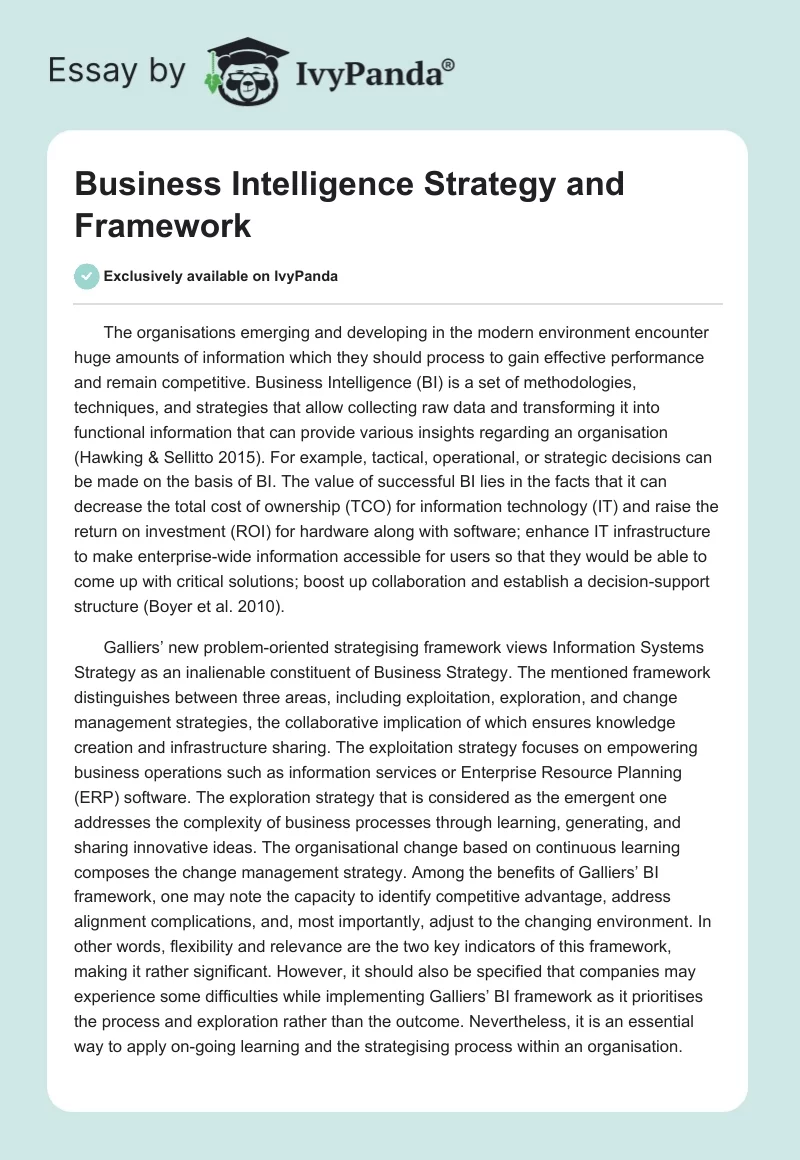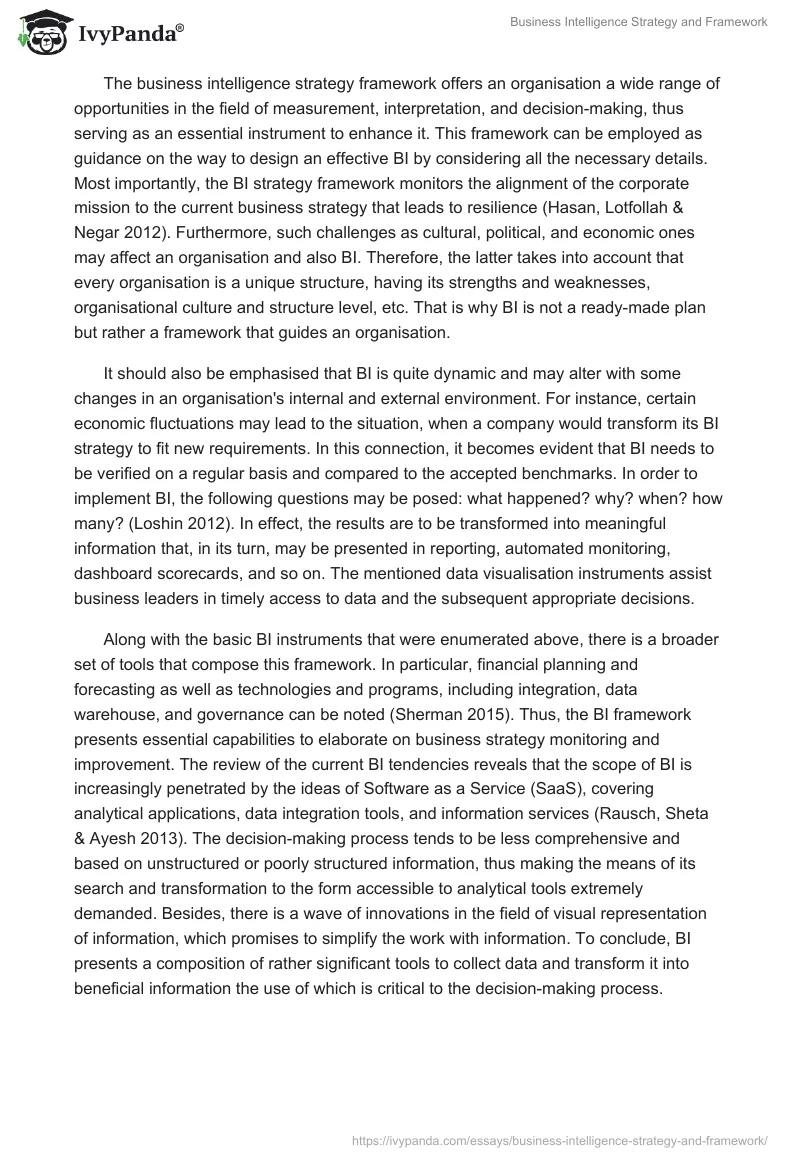The organisations emerging and developing in the modern environment encounter huge amounts of information which they should process to gain effective performance and remain competitive. Business Intelligence (BI) is a set of methodologies, techniques, and strategies that allow collecting raw data and transforming it into functional information that can provide various insights regarding an organisation (Hawking & Sellitto 2015). For example, tactical, operational, or strategic decisions can be made on the basis of BI. The value of successful BI lies in the facts that it can decrease the total cost of ownership (TCO) for information technology (IT) and raise the return on investment (ROI) for hardware along with software; enhance IT infrastructure to make enterprise-wide information accessible for users so that they would be able to come up with critical solutions; boost up collaboration and establish a decision-support structure (Boyer et al. 2010).
Galliers’ new problem-oriented strategising framework views Information Systems Strategy as an inalienable constituent of Business Strategy. The mentioned framework distinguishes between three areas, including exploitation, exploration, and change management strategies, the collaborative implication of which ensures knowledge creation and infrastructure sharing. The exploitation strategy focuses on empowering business operations such as information services or Enterprise Resource Planning (ERP) software.
The exploration strategy that is considered as the emergent one addresses the complexity of business processes through learning, generating, and sharing innovative ideas. The organisational change based on continuous learning composes the change management strategy. Among the benefits of Galliers’ BI framework, one may note the capacity to identify competitive advantage, address alignment complications, and, most importantly, adjust to the changing environment. In other words, flexibility and relevance are the two key indicators of this framework, making it rather significant. However, it should also be specified that companies may experience some difficulties while implementing Galliers’ BI framework as it prioritises the process and exploration rather than the outcome. Nevertheless, it is an essential way to apply on-going learning and the strategising process within an organisation.
The business intelligence strategy framework offers an organisation a wide range of opportunities in the field of measurement, interpretation, and decision-making, thus serving as an essential instrument to enhance it. This framework can be employed as guidance on the way to design an effective BI by considering all the necessary details. Most importantly, the BI strategy framework monitors the alignment of the corporate mission to the current business strategy that leads to resilience (Hasan, Lotfollah & Negar 2012). Furthermore, such challenges as cultural, political, and economic ones may affect an organisation and also BI. Therefore, the latter takes into account that every organisation is a unique structure, having its strengths and weaknesses, organisational culture and structure level, etc. That is why BI is not a ready-made plan but rather a framework that guides an organisation.
It should also be emphasised that BI is quite dynamic and may alter with some changes in an organisation’s internal and external environment. For instance, certain economic fluctuations may lead to the situation, when a company would transform its BI strategy to fit new requirements. In this connection, it becomes evident that BI needs to be verified on a regular basis and compared to the accepted benchmarks. In order to implement BI, the following questions may be posed: what happened? why? when? how many? (Loshin 2012). In effect, the results are to be transformed into meaningful information that, in its turn, may be presented in reporting, automated monitoring, dashboard scorecards, and so on. The mentioned data visualisation instruments assist business leaders in timely access to data and the subsequent appropriate decisions.
Along with the basic BI instruments that were enumerated above, there is a broader set of tools that compose this framework. In particular, financial planning and forecasting as well as technologies and programs, including integration, data warehouse, and governance can be noted (Sherman 2015). Thus, the BI framework presents essential capabilities to elaborate on business strategy monitoring and improvement. The review of the current BI tendencies reveals that the scope of BI is increasingly penetrated by the ideas of Software as a Service (SaaS), covering analytical applications, data integration tools, and information services (Rausch, Sheta & Ayesh 2013).
The decision-making process tends to be less comprehensive and based on unstructured or poorly structured information, thus making the means of its search and transformation to the form accessible to analytical tools extremely demanded. Besides, there is a wave of innovations in the field of visual representation of information, which promises to simplify the work with information. To conclude, BI presents a composition of rather significant tools to collect data and transform it into beneficial information the use of which is critical to the decision-making process.
Reference List
Boyer, J, Frank, B, Green, B, Harris, T & Van De Vanter, K 2010, Business intelligence strategy, MC Press, Ketchum.
Hasan, HM, Lotfollah, F & Negar, M 2012, ‘Comprehensive model of business intelligence: a case study of Nano’s companies’, Indian Journal of Science & Technology, vol. 5, no. 6, pp. 2851-2859.
Hawking, P & Sellitto, K 2015, ‘Business intelligence strategy: a utilities company case study’, International Journal of Enterprise Information Systems, vol. 11, no. 2, pp. 1-12.
Loshin, D 2012, Business intelligence: the savvy manager’s guide, Elsevier, Waltham.
Rausch, P, Sheta, AF & Ayesh, A 2013, Business intelligence and performance management: theory, systems and industrial applications, Springer, London.
Sherman, R 2015, Why a BI environment needs a solid architecture framework, Web.


